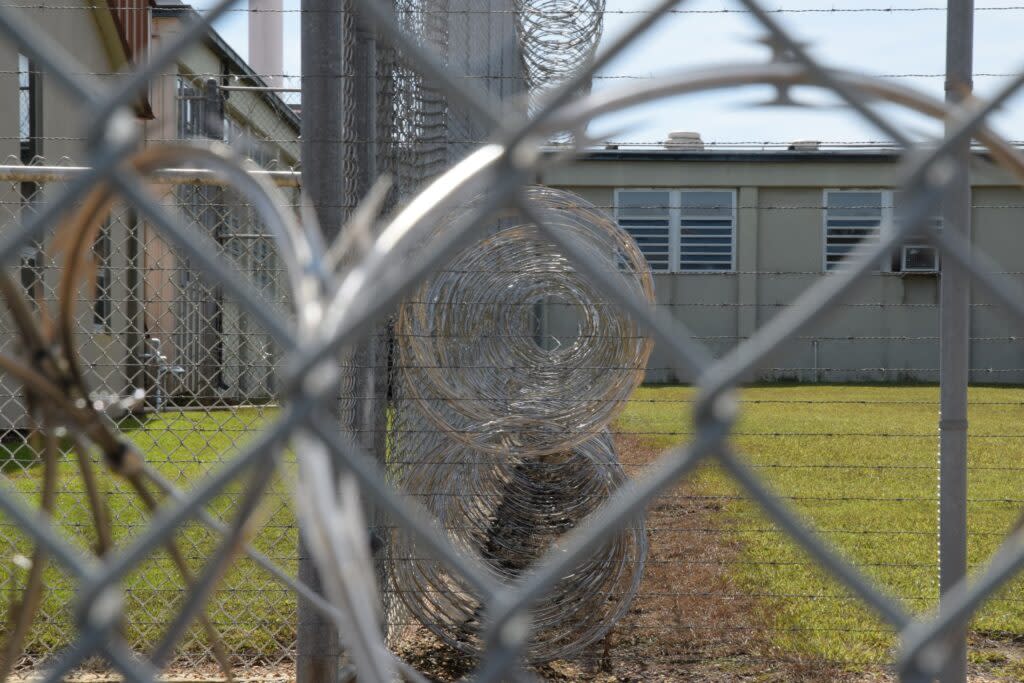Alabama Department of Corrections: Staff recruitment flat, incarcerated population up

Barbed wire seen behind a fence at an Alabama prison. (Brian Lyman/Alabama Reflector)
The commissioner of the Alabama Department of Corrections said Tuesday the department continues to struggle to hire and retain staff as the state’s prison population is rising.
The prison population increased about 18% between 2021 and 2024, according to figures ADOC Commissioner John Hamm presented to members of the Joint Prison Oversight Commission.
“We don’t have any control over inmates coming to the Department of Corrections,” Hamm said to reporters after the meeting. “Local law enforcement makes arrests, investigators investigate, and judges sentence, so we have no control over that.”
GET THE MORNING HEADLINES DELIVERED TO YOUR INBOX
Multiple factors have contributed to the heightened influx of people entering the state’s prison facilities, but the COVID-19 pandemic is a significant one.
DOC’s in-house numbers fell sharply in 2020 after the department stopped accepting new inmates amid the outbreak. In February 2020, a month before the first COVID cases were confirmed in Alabama, the prison population was 21,272. It fell to 16,792 in May 2021, the lowest number in decades, but began rising rapidly as intake resumed. The incarcerated population hit 20,469 in January.
Hamm also said bills passed by the Legislature contribute to increases in the prison population, though he did not go into specifics. The commissioner said that Corrections is collaborating with the Sentencing Commission to model the impact of legislation on the prison population.
“We are trying to get an assessment of what all the new laws are going to do for us as far as the population goes,” Hamm said.
The declining parole rate has been an ongoing concern for criminal justice reform advocates. According to a report published by the ACLU of Alabama in September, the Alabama Board of Pardons and Paroles granted parole to about 7% of those eligible.
That parole rate, taken from data collected from 267 proceedings from July to August, is a dramatic decline in the number of paroles the Board had granted from as recently as 2017, when the rate was about 54%.
“We would like to see more individuals get an opportunity to get out,” Hamm said.
The lower parole rates complicate Corrections’ ability to house the inmates it has, the commissioner said.
“When an individual comes in, you have to match the individual, the classification, the crime, with the bed,” Hamm said. “You are not going to put a capital murderer in a workplace bed. Most of our beds that we need are medium-custody beds, and maximum-custody beds, so when those are not available, it kind of puts a strain on us.”
The growing prison population has complicated the logistics related to the facilities. The original plan when legislators approved the construction of the two men’s facilities in Elmore and Escambia counties included closing some facilities.
The Kilby Corrections Facility, an intake center located outside Montgomery, will close and its responsibilities will be shifted to the new prison in Elmore, Hamm said.
“I guess what I am struggling with is how we are going to close facilities that can house 5,000 people when we have 20,000 in prison,” said Rep. Jim Hill, R-Odenville.
The two mega prisons as planned were intended to replace existing, aging facilities. But the growing prison population could make it hard to do that.
“That is going to be an interesting debate,” Hamm said.
Recruitment and retention
Hamm told committee members the Department has been making some progress toward filling vacancies.
According to Hamm’s presentation, 31 correctional officers graduated from the ADOC Training Academy in Selma in March who can serve as security guards. Another 61 correctional officer trainees will graduate April 4, while another 140 recruits will report to training on April 14.
Despite that, vacancies continue to remain an issue. Based on the number Hamm presented, of the more than 2,445 total budgeted security positions, 365 remain vacant. Of the 1,407 budgeted administrative personnel, 448 are still unfilled.
Retention is difficult, Hamm said, because Corrections requires its posts to be staffed every day. The job is also stressful, with challenging work conditions that offer little connection to people outside of the facility.
Turnover is a second problem, with rates higher than other jobs in the market. Many opt to work in other industries or other careers in lieu of a career as a corrections officer.
There are also stringent hiring requirements. There are strict physical, educational and background check requirements.
“We had about 498 applicants who were going through for this class,” Hamm said. “3 of them resigned after starting the first day. 2 failed a drug test the first day they showed up for work.”
On top of that, an additional assessment revealed that 49 applicants were not recommended to be hired because they are suspected gang members.
“That is something we deal with quite regularly,” Hamm said during his presentation. “We had 151 that have gang affiliations that we are doing a more in-depth background check on. That is who we have showing up sometimes.”
“My job is difficult, period,” Hamm said to reporters. “There is no one silver bullet to fix this stuff and there is no one issue that has us in this situation.”
The post Alabama Department of Corrections: Staff recruitment flat, incarcerated population up appeared first on Alabama Reflector.

